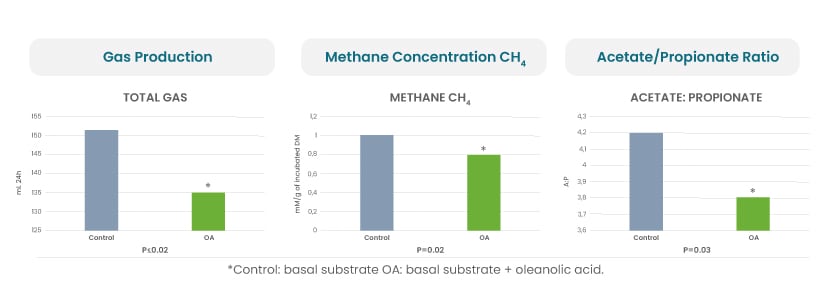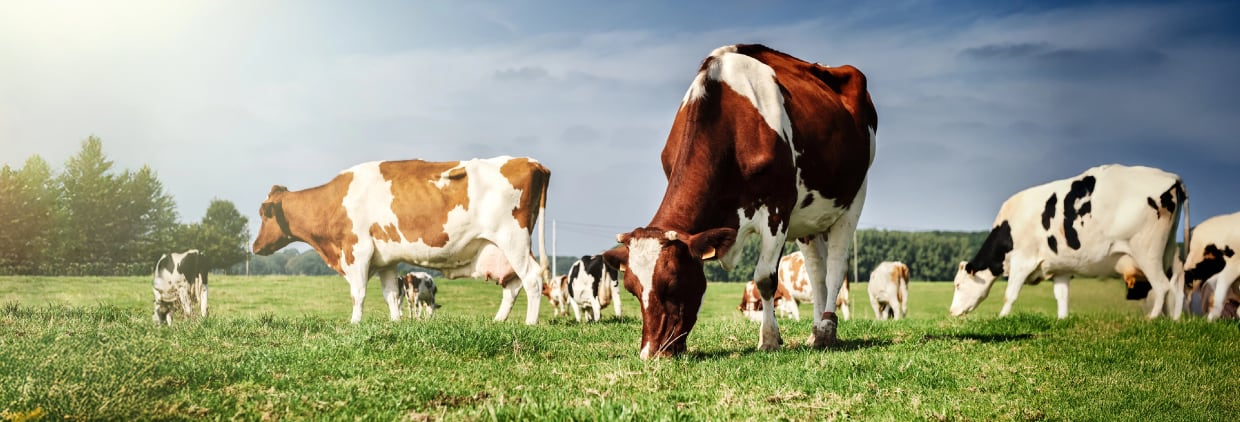Methane is a highly potent greenhouse gas (GHG) responsible for approximately 20% of global GHG emissions.¹
It traps about 25 times more heat in the atmosphere than carbon dioxide and significantly contributes to global warming.¹

The elevated warming potential makes it a major contributor to short-term climate change, with impacts that include increased frequency of extreme weather events, accelerated ice melt, rising sea levels, and disruption to ecosystems and agriculture.²
Climate change is globally relevant. International treaties like the Paris Agreement are in place to highlight the urgency of reducing short-lived climate pollutants like methane, seeking to limit the global temperature rise to well below 2°C, above pre-industrial levels.³
The livestock sector is a major source of methane emissions, particularly ruminant animals like cattle, and has come under increasing scrutiny. In line with the goals of the Paris Agreement, the animal feed industry is being pushed to adopt more sustainable practices that can reduce methane production from enteric fermentation (the natural digestive process in ruminant animals). Given that methane has a relatively short atmospheric lifetime – approximately 12 years – reducing its emissions can yield rapid climate benefits.
For the oil and gas sector, this implies stricter regulation, and the adoption of technologies aimed at leak detection, methane capture, and operational efficiency to align with global mitigation targets.⁴
Enhancing the efficiency of fermentation
In 2020, it was estimated that 27% of anthropogenic methane emissions (human-caused methane releases) originated from enteric fermentation in ruminants, while 24% came from the oil and gas sector.⁵
Enteric methane is produced during the natural digestive process of ruminants, and is produced during enteric fermentation.⁶
In this process, microorganisms in the rumen ferment ingested feed to produce volatile fatty acids (VFAs) – mainly acetate and propionate – that serve as key energy sources for ruminants. A by-product of this microbial fermentation is methane (CH4), generated primarily from hydrogen (H2) and carbon dioxide (CO2) by methanogenic archaea.⁷⁻⁸
The amount of methane emitted depends largely on the type and amount of feed animals consume. Improving how well animals digest their food and balancing their diets can make fermentation in their stomachs more efficient, which helps cut down methane emissions.
For example, certain diets encourage the production of propionate instead of acetate. This matters because propionate uses up hydrogen during digestion – hydrogen that would otherwise be used by microbes to create methane gas.
On the other hand, diets that produce more acetate or butyrate release extra hydrogen, giving methanogens the fuel they need to produce more methane. By shifting the balance toward propionate, farmers can reduce GHG emissions while also improving the animals’ energy use.⁹⁻¹⁰
According to several studies, the ruminal fermentation process can be modified to reduce methane emissions.¹¹⁻¹² One effective strategy involves altering the ruminants diet composition to promote the formation of propionate over acetate, which has been shown to lower methane production without compromising digestive efficiency.¹³⁻¹⁴
Several mitigation strategies have emerged, including the use of feed additives, dietary reformulation, and the integration of plant-based bioactives. One promising area of research focuses on plant secondary metabolites, such as triterpenes, which exhibit antimicrobial properties that can modulate rumen microbiota.

Analyzing olive triterpenes
Natac, alongside other expert teams, participated in an innovative in vitro study with the objective of analyzing olive triterpenes (Olea europaea L.) potential in modulating ruminal fermentation.¹⁵
The study comprised of two experiments, designed to test the effects of different olive triterpenes on in vitro ruminal fermentation. In the first experiment a batch culture was performed with increasing dosages of triterpenes (up to 100 mg/L of inoculum).
Oleanolic acid was selected for the second experiment, in conjunction with an oleanolic acid derivative of 200 mg/L inoculum. In both experiments the dosage of 0 mg/L was chosen as the negative control, and sodium monensin at 4mg/L was selected as the positive control. The ruminal fluid was collected from four crossbred steers after two weeks consuming either a highly fermentable by-product diet or a forage-based diet.
A substrate, rich in fiber and cellulose, was used to evaluate the impact of the oleanolic acid (OA) in its most bioavailable form on ruminal fermentation, various parameters were measured.

Results suggest:
- Oleanolic acid decreased the gas production, including methane
- The decrease in CH4 production was influenced by a change in the acetate to proportionate ratio
- The increase in proportionate production, at the expense of acetate, decreased the availability of H2, limiting methane production
The results of this study suggest that bioavailable OA has significant potential to enhance rumen fermentation, comparable to the effects of monensin, and could thus help reduce the need for antibiotics.
This approach could offer a multifaceted solution to some of the most pressing challenges in animal agriculture. Reducing enteric methane emissions, it directly contributes to mitigating the environmental impact of livestock.
This is essential in the broader context of climate change mitigation goals outlined by international frameworks such as the Paris Agreement.³ At the same time, incorporating natural bioactive compounds into animal diets – such as olive triterpenes – can promote more sustainable livestock production systems.¹⁶
Improving animal welfare
Moreover, this strategy aligns with improving animal welfare, as better feed conversion and reduced ruminal stress could translate into improved wellbeing and productivity for the animals. Healthier animals are more resilient, require fewer medical interventions, and contribute to lower environmental burdens per unit of product, such as meat or milk.
The adoption of such approaches supports the transition toward climate-smart and environmentally responsible agriculture, addressing both ecological and ethical concerns. As global demand for animal-based products continues to rise, solutions that balance productivity with sustainability and animal wellbeing will be increasingly critical for shaping the future of agriculture.
References
- Comisión Europea. Methane emissions.
- United Nations Environment Programme (UNEP). Global Methane Assessment: Benefits and Costs of Mitigating Methane Emissions. 2021.
- United Nations Framework Convention on Climate Change (UNFCCC). The Paris Agreement.
- International Energy Agency (IEA). Curtailing Methane Emissions from Fossil Fuel Operations: Pathways to a 75% Cut by 2030.
- IPCC (2022). AR6 Climate Change 2022: Mitigation of Climate Change.
- Knapp, J. R.; et al. (2014). Enteric methane in dairy cattle production: Quantifying the opportunities and impact of reducing emissions. Journal of Dairy Science, 97, 3231–3261.
- Beauchemin, K. A.; et al. (2009). Crushed sunflower, flax, or canola seeds in lactating dairy cow diets: Effects on methane production, rumen fermentation, and milk production. Journal of Dairy Science, 92, 2118–2127.
- American Society for Microbiology. Ruminant Methanogens as a Climate Change Target. 2024.
- Mitsumori, M.; et al. (2008). Methane production from rumen fermentation: new mitigation strategies. Animal Science Journal, 79(3), 257–267.
- Moss, A. R.; (2000). Methane production by ruminants: Its contribution to global warming. Annales de Zootechnie, 49(3), 231–253.
- Hristov.; et al. (2013). Mitigation of methane and nitrous oxide emissions from animal operations: I. A review of enteric methane mitigation options. Journal of Animal Science, 91(11), 5045–5069.
- Króliczewska, B.; et al. (2023). Strategies Used to Reduce Methane Emissions from Ruminants: Controversies and Issues. Agriculture, 13(3), 602.
- Beauchemin, K. A.; et al. (2008). Nutritional management for enteric methane abatement: a review. Australian Journal of Experimental Agriculture, 48(2), 21-27.
- Haque, M. (2018). Dietary manipulation: a sustainable way to mitigate methane emissions from ruminants. J Anim Sci Technol, 60(15).
- Cangiano, L.; et al. (2022). Triterpenes from Olea europaea modulate in vitro ruminal fermentation. Transl Anim Sci. 2022 May 6;6(2):txac056.
- Beauchemin, K.A.; et al. (2020). Fifty years of research on rumen methanogenesis: lessons learned and future challenges for mitigation. Animal, 14(S1), s2–s16.


